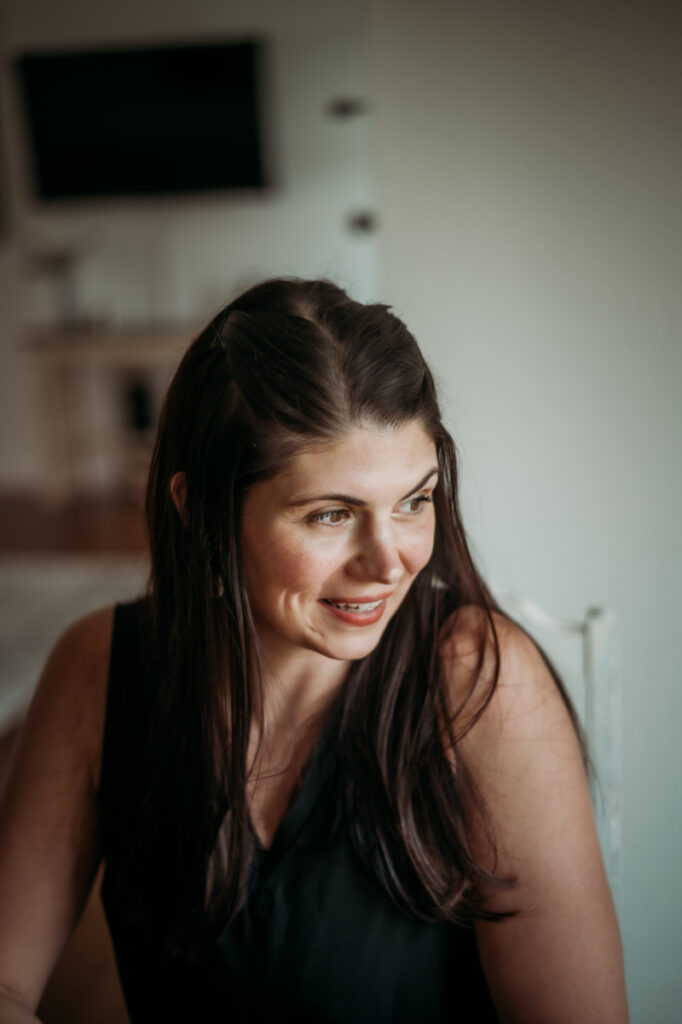How to Stop Waiting for the “Perfect Time” to Live Your Life
June 24, 2025
We tell ourselves we’ll start later—once the anxiety eases, the house is clean, the schedule clears, or we finally feel “ready.”
But here’s what I’ve learned—both in my own life and in the lives of the clients I work with every day: waiting for the perfect time is a trap. It keeps you stuck. And it stops you from doing the one thing your anxiety doesn’t want you to do—live your life.
Trust me, you don’t need to have it all figured out. You don’t need to wait until the fear is gone. You can start now. Even if it’s messy. Even if it’s small.
If you’re new around here, hi, I’m Jenna! A LPC, mom, and someone who knows how easy it is to put life on hold when anxiety and perfectionism are in the driver’s seat. That’s why I created practical tools (like my podcast, online course, and daily resources) to help you stop waiting and start living your life—even when it feels hard.

Why We Keep Delaying What We Want
It’s usually not laziness. It’s fear. Fear of failing. Fear of making the wrong choice. And fear of regret.
Sometimes it’s anxiety saying, “What if you can’t handle it?”
Sometimes it’s OCD whispering, “Not yet. It’s not safe.”
And sometimes, it’s just exhaustion. Because perfectionism and mental load will wear you down. (Especially if you’re also parenting, working, or just trying to function in a chaotic world.)
But here’s the thing: waiting for life to feel safe or certain doesn’t bring relief. It actually fuels more anxiety. It reinforces the idea that you can’t handle life until things are “just right.”
And if perfectionism is a theme for you, I break that down more in Perfectionism OCD and the “Just Right” Feeling: Why Perfectionism Can Be a Compulsion. It might help you see the pattern more clearly.
The Cost of Waiting for the “Perfect Time” to Live Your Life
Here’s the hard truth: the longer you wait to live your life, the heavier life feels. Not because you’re doing anything wrong—but because avoidance builds pressure.
Every time you delay a step forward, it confirms the lie that you’re not ready. And your brain learns to fear the very things that might bring growth, joy, or freedom.
That avoidance shows up in sneaky ways:
- Putting off the job application that excites you
- Skipping the trip you’ve wanted to take for years
- Avoiding a new routine that might actually help
- Freezing on the next exposure you meant to try
- Staying quiet instead of asking for what you need
Before you know it, your days fill with waiting, and your anxiety grows stronger—not because you’re weak, but because your brain is trying to protect you from something it thinks is dangerous.
But here’s what I want you to know: you don’t need the perfect moment to start. You just need a willingness to try—even while the fear is still there.
And if you’ve ever struggled with the “all or nothing” mindset, my blog Progress vs. Perfection: Why Small Wins Matter in OCD Recovery breaks that down. It’s a helpful reminder that imperfect action is still powerful.

How Perfectionism Keeps You Stuck
Perfectionism is sneaky. It sounds responsible. It sounds like planning. It can even look like self-care. But often, it’s just fear in disguise.
When perfectionism shows up in OCD or anxiety, it convinces you that you need more certainty, more time, more control before taking action.
But the truth? That “perfect” feeling never comes. And the longer you chase it, the more paralyzed you feel.
Here’s how perfectionism can keep you from living your life:
- Searching for the “perfect” ERP plan before starting
- Waiting until your house or mind is calm before resting
- Holding off on joy until anxiety is completely gone
- Overthinking every next step instead of taking any
It’s like being stuck at a red light that never turns green.
Instead of waiting, try asking yourself: What’s one small step I can take today, even if it’s not perfect?
If you’re looking for a reminder of why small daily choices matter, my blog Why Little Reminders Matter: How Positive Affirmations Can Change Your Daily Mindset offers simple but powerful mindset shifts.
How to Live Your Life Now, Even If You Don’t Feel Ready
You don’t need to be fearless to live your life. You just need to stop letting fear be the decision-maker.
Here’s what that can look like:
- Choose presence over performance. You don’t need to get it right. You just need to show up.
- Take messy action. That phone call. That exposure. And that conversation. Do it scared.
- Notice what brings you to life—and do more of that. Even for five minutes.
- Drop the mental checklist. There’s no magical order you have to follow.
And if you’re deep in recovery work and unsure how to organize it all, check out How to Manage Anxiety and OCD: Why Keeping Your Recovery Tools Front and Center Matters. It’s full of practical tips to help you act, even on tough days.
Areas of Life Where This Mindset Shift Matters
This isn’t just about big life changes. This mindset shift touches every part of how you move through your day. Here’s where I see it show up most often:
Parenting
You don’t need to be the perfect parent to make a lasting impact. Your presence, not your perfection, is what matters most.
Relationships
Say the thing. Ask the question. Share how you feel. Waiting until you’re 100% sure often leads to missed connections.
Speaking of relationships. Are you wondering how to support a loved one with OCD? Check out my blog here.
Recovery
Exposure Response Prevention (ERP) doesn’t get easier with more time, it gets easier with practice. Start where you are, not where you wish you were.
Joy
You’re allowed to feel joy even when things are hard. You’re allowed to laugh, rest, and enjoy your life even when the anxiety is still there.
Because here’s the truth: you don’t have to wait until you’re symptom-free to live your life.
You can live your life with the anxiety. With the uncertainty. With the messiness. That’s where real healing happens.

You’re Allowed to Live Your Life Now
The perfect time doesn’t exist. But this moment? It’s real. And it’s enough.
So don’t wait. Start now. However small. However imperfect.
If you’re looking for deeper guidance, my OCD and Anxiety Recovery Blueprint is a online course built to help you live your life—even in the middle of uncertainty. You can check it out right here.
And if you want gentle nudges and visual reminders along the way, my Break Free collection was made for that. Whether it’s stickers, sweatshirts, the Break Free Affirmation Deck, or calming air fresheners, these tools are here to support you. Shop it all here.
You can also tune into my podcast, All The Hard Things, where I talk about OCD and anxiety recovery, mindset shifts, and how to stop waiting for the “right” time to start living.
You don’t need perfect conditions to live your life. You just need the courage to start—right where you are.
most popular episodes
Love my podcast?
Episode 112: Postpartum OCD and False Memory OCD
Imagine how in depth I can go in an online course. Instantly downloadable and game-changing. Take the next step towards an amazing life.